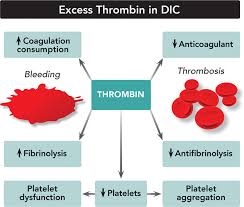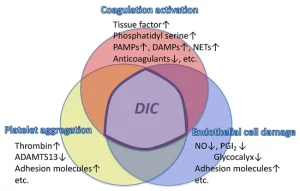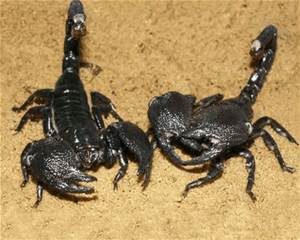
1-The Scorpions
They outlasted the Dinosaurs, There are about 1500 species in all. This creature may not look so threatening to the human eye but believe or not some of these scorpions can be highly venomous like in North Africa and in the Middle East; that is responsible for over 75% of scorpion related deaths every year. This scorpion is the Death Stalker Scorpion. All scorpions are considered to be arachnids, 4 pairs of legs for walking, a pair of pincers for holding prey, and mouth parts called chelicerae(s) to chew, the body tapers ending at its stinger and use it usually as a last resort. Most scorpions are shy and lie around waiting for its prey like a roach, cricket, etc… to even eating themselves; including rather than humans it usually only eats insects and stings humans in defense feeling threatened usually (the sting as a last resort). They are nocturnal insects usually. Scorpions are built for battle and crush their prey and immobilize (by paralyzing)them with that venom with sometimes doing it to their own species (eating their own sibling even).
Though do not blind or kid yourselves if living in America thinking there is no killer scorpion in this country is so off base. There are varying types in all countries but Antarctica. Of those 1500 species only a few dozen are potentially lethal to human beings.
Indian Red Scorpion
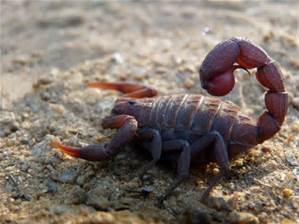
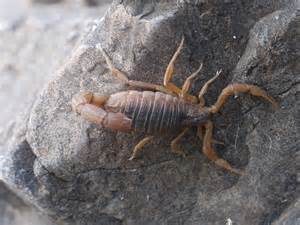
One of the top deadliest to humans is the sting of the Indian Red Scorpion. National Geographic-NG states it’s the most lethal of all. It’s only a tiny creature that possesses a killing elixir. NG states if it lives near people it often takes shelter where they do; and states this creatures is in countries like India, scorpion stings are a serious public health issue, particularly children (a country to walk commonly bare foot in the road/streets).
In the U.S. they are also found in the southwest, preferring the warm, dry climates found in Arizona, California and New Mexico.
Children are particularly susceptible to these bites and are more likely to die from them than adults. Although healthy adults usually only feel unbearable pain, children that are envenomated suffering a fever, coma, convulsions, and paralysis before their lungs fill up and they drown in their own fluids.
Fat Tailed Scorpions
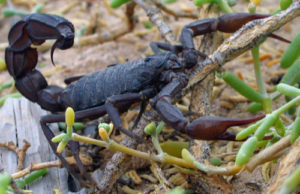
Also known as fat tailed,Androctonus Scorpion is the most dangerous scorpion specie found in the world. Just 4 inches in length, this beast can kill human beings in minutes.Androctonus mostly lives under rocks and other shelter. They avoid coastal areas or anywhere that is high humidity. Some individuals may burrow from time to time. Unfortunately, their hiding places are often located near humans. Androctonus is widespread in Morocco, Algeria, Tunisia, Libya, Egypt, Togo, Israel, India, Lebanon, Turkey, Jordan, Saudi Arabia, Yemen, Oman, United Arab Emirates, Qatar, Kuwait, Iraq, Iran, Afghanistan, Bahrain and Pakistan.
Death Stalker Scorpion
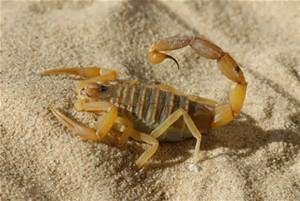
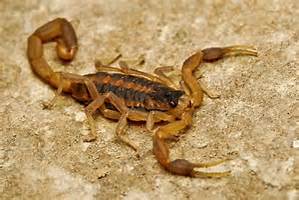
Commonly known as Death Stalker, this specie is second most dangerous in our list. The death stalker is regarded as a highly dangerous species because its venom is most powerful and most painful and can kill children and elderly. People can be found in the desert and scrubland habitats ranging from North Africa through to the Middle East. Countries where it lives include Algeria, Bahrain, Chad, Egypt, Ethiopia, Libya, Mali, Niger, Somalia, Sudan, Tunisia, Iraq, Israel, Jordan, Kuwait, Lebanon, Oman, Iran, Afghanistan, Pakistan, Qatar, Saudi Arabia, and Yemen.
Gormar Scorpion
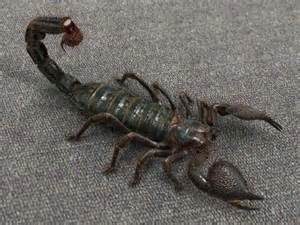
The gormar scorpion ranges from 4 to 5 inches in length and weighs several ounces. It is solid black with an exceptionally thick exoskeleton and black legs with a slightly reddish tinge The Gormar Scorpion has a large tail and a particularly large stinger. Its ability to kill anyone in 10 minutes is the reason we have Gormar one of the top deadliest scorpions. Gormar scorpions live only in Venezuela. They make their homes in the jungles and tropical rain forests of the country. A single Gormar sting can kill an average-sized man in a few minutes. There is no anti-venom, so a person who has been stung must be treated with vasodilators and analgesics.
Red Claw Scorpion

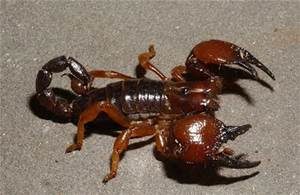
The Red Claw Scorpion has commonly been called the Tanzanian Red Claw. Its scientific name is Pandinus Cavimanus. The sting of a Red Claw Scorpion has been compared to the sting of a bee. Children who get stung by them can get badly hurt, and can even die as a result of an allergic reaction. They are found living within humid rainforests of Tanzanian, Africa. They like to hide and may be found living under rocks, fallen logs or in shallow burrows.
Emperor Scorpion
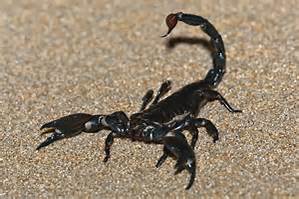
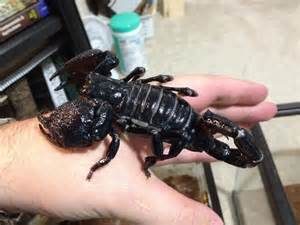
The Emperor Scorpion is native to Africa. It is one of the largest scorpions in the world and lives for 5–8 years. It has a large, shiny black body and bumpy pincers. Its venom is mild and the scorpion as a whole is not very aggressive. The emperor scorpion is an African rainforest species. It is found in a number of African countries, including Benin, Burkina Faso, Côte d’Ivoire, Ghana, Guinea, Togo, Liberia, Mali, Nigeria.
Other deadly ones found in America:
Arizona Bark Scorpion:
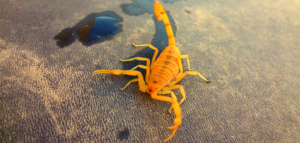
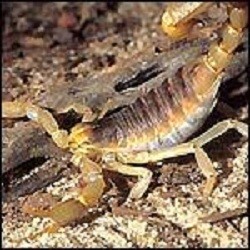
Size
The average length of mature Bark Scorpions is 1.5 inches.
Description
The Arizona Bark Scorpion is typically a golden-yellow color or very light brown.. It has a slender tail and pincers.
Distribution
In the United States, the Arizona Bark Scorpion is found in Arizona, California, Nevada, New Mexico and Utah. Outside of the United States, it is found in Northwestern Mexico.
Stripe Backed Scorpion:
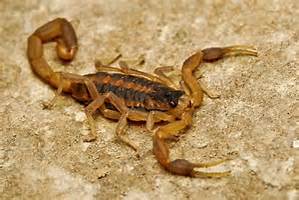
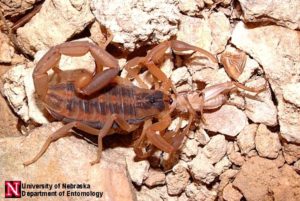
Size
The average length of mature Stripe backed Scorpions is 2.5 inches.
Description
The Stripe Backed Scorpion varies in color from yellowish-tan to brown. As you can see in the picture below, the Stripe Backed Scorpion has 2 dark gray lines that run the length of it’s back. Older scorpions tend to be a darker brown, and the stripes may not be as obvious.
Distribution
In the United States, the Stripe Backed Scorpion is found in Arizona, Arkansas, Colorado, Illinois, Kansas, Louisiana, Mississippi, Missouri, Nebraska, New Mexico, Oklahoma, Tennessee, and Texas. It is the most widespread scorpion in the United States. Outside of the United States, it is found in Northern Mexico.
So you may want to study about areas you travel to (especially warm climate areas for hiking and nice weather to even camping) in knowing what the state or country is known for in animals or creatures that could cause injury to you or even kill you with knowing how to prevent it, if possible.

















